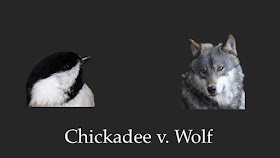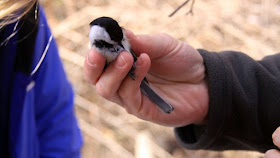 |
| John LaTourelle Photography, TEDxBemidji |
 |
| Copyright 2018 by Lisa Johnson |
I didn’t discover chickadees until I was 23, but I quickly fell in love with them, too. When I have a problem, I often think, “How would a chickadee handle this?” It never occurs to me to wonder what a wolf would do.
 |
| Copyright 2018 by Lynne Casperson Schoenborn |
While putting this talk together, I asked a few friends which they would rather be—a wolf or a chickadee. Just about everyone went with wolves. Why? “No one messes with them.” “Wolves can take care of themselves.” And especially, “Wolves live longer.” But that one’s not true. Few wolves or chickadees survive their first year, but once they do, both species have a life expectancy of 4-8 years, and in both cases, some live much longer—wild wolves to 13 and chickadees to 12.
A 150-pound wolf would balance roughly 6,000 chickadees. But for their size, chickadees are every bit as fierce when ferocity is called for.
 |
| Wolf photo copyright 2018 by Lisa Johnson |
Ask any bird bander. If you grab a chickadee against its will, you are going to get walloped…
... and chickadees know right where to peck and bite to inflict the most pain. A chickadee battling a bird bander is like Ahab stabbing Moby Dick himself.
A wolf would have to face a predator the size of the largest sperm whale on earth to measure up to a chickadee facing a bander.
But in a chickadee’s everyday life, curiosity and open-mindedness are much more valuable than ferocity. Hunters often tell me about hand-feeding chickadees up in their deer stands. Some chickadees even alight on their eyeglasses, hats, or beards to pick at dried blood on their faces. Hunters get a kick out of it, and chickadees get protein. Win-win.
We romanticize ferocity in a way I didn’t understand when I first read White Fang. When the little wolf cub left his mother’s den for the first time, he chanced upon a nestful of ptarmigan chicks and gobbled them up, and when their mother flew in, he killed and ate her, too.
He obviously had to hunt to survive, but Jack London’s salivating prose seemed excessive: “The lust to kill was on him... He was thrilling and exulting in ways new to him and greater to him than any he had known before.”
 |
| Copyright 2018 by Melissa Groo |
or a grosbeak exultantly chomping the life out of a box elder seed. No wonder Teddy Roosevelt panned Jack London’s books.
The magnificence of wolves and their importance in the web of life cannot be denied, but we glamorize “nature red in tooth and claw” as if nature’s vegetarians and insectivores aren’t equally vital and evolutionarily fit.
 |
| Copyright 2018 by Melissa Groo |
 |
| Copyright 2018 by Lynne Casperson Schoenborn |
 |
| Wolf photo copyright 2018 by Lisa Johnson |
And like them, we’re territorial but have to tolerate our neighbors. Chickadees sometimes squabble, but I’ve never witnessed a physical fight. They solve disputes with vocalizations and having the brains and humility to admit when they lose a debate. Coming to blows would be uncivilized.
Wolves avoid some fights by intimidation, faking dominance with aggressive posturing.
 |
| Copyright 2018 by Lisa Johnson |
Like wolves and baby chickadees, we humans bluff, bluster, and posture. Standing on this stage right now is Exhibit A. I was coached on how to appear more credible than I maybe really am. Should you believe anything I say when I’m putting on airs like a baby chickadee? Judge my words and facts, so you can do what any mature chickadee does—distinguish truth from a con.
A high rank assures a wolf of more food than its pack mates right up until it gets killed or wounded by one of those pack mates. It’s a zero-sum game—for one wolf to win, another must lose.
 | |
|
Wolves form packs because it takes coordinated effort to kill large prey, but once the moose is down, wolves fight fiercely over who gets what.
 |
| Copyright 2018 by Lisa Johnson |
But those same tiny capitalists also embody the best of socialism. If lightning blasts the birch where a chickadee squirreled away most of its food stores, it’s welcome to raid other chickadees’ caches. In their world, it’s all for one, and one for all.
Chickadees don’t kill their enemies. They mob little owls, trying to drive them off, but when they spot most predators, they simply fly away. And the more eyes looking for danger, the easier to elude it.
That’s why chickadees welcome all kinds of birds into their flocks regardless of race, color, sex, or even species, as long as they’re not predators. Homeless, tempest-tossed warblers passing through Minnesota in spring and fall know which bird lifts its lamp to welcome them.
Chickadees don’t just believe in inclusiveness—they thrive because of it.
I reread White Fang a few weeks ago. I still love that little wolf cub and the magnificent animal he became, but it isn’t just the over-romanticizing of killing, and the ugly racism I had no way of seeing as an 8-year-old white girl from Chicago, that now make me cringe.
Jack London wrote of a silent, desolate world of "laughter more terrible than any sadness... it was…eternity laughing at the futility of life ... It was … the savage, frozen-hearted Northland Wild."
Oh, come on! I remember February 2, 1996, when we hit that record 60 below zero. That morning was hardly silent or desolate. Someone slept in a snow fort up in Tower, emerging triumphantly at first light to cameras, microphones, and cheers, while no one even noticed all the chickadees calling and singing in the background.
They had each slept in their own little cavity or crevice, naked as jaybirds, no hand-warmers or camp stoves for them, and come morning, those tiny survivors went about their business like 60 below was no big deal.
Aldo Leopold loved wolves, but he didn’t hear the terrible, mirthless laughter of Jack London’s wild imaginings.
 |
| Copyright 2018 by Lisa Johnson |
That whimsical fellow called evolution, having enlarged the dinosaur until he tripped over his own toes, tried shrinking the chickadee until he was just too big to be snapped up by flycatchers as an insect, and just too little to be pursued by hawks and owls as meat. Then he regarded his handiwork and laughed. Everyone laughs at so small a bundle of large enthusiasms.
Right now, our country needs joyful, shared laughter. And we need something more. I wish that we, the only species on earth whose numbers include actual rocket scientists, could harness our intelligence to figure out how to live up to the Preamble to our own Constitution the way chickadees do.
They establish justice, insure domestic tranquility, provide for the common defense, promote the general welfare, and secure the blessings of liberty to themselves and their posterity.
We’re the ones who had the brains and heart to articulate that vision 230 years ago, yet we seem further from achieving it now than ever before. Let’s look to chickadees to lighten our hearts and light our way.





















